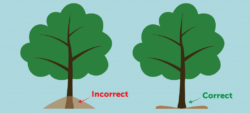Spring is a time for renewal, and our gardens and planting beds are no exception. When used correctly, mulch can benefit your landscape, both in terms of plant health and aesthetics. If you are planning to add mulch to your landscape this spring, here are some tips.
Why mulch?
A layer of mulch can help suppress weeds, retain moisture, and prevent erosion in your planting beds. But when it comes to mulch, less is more. When added year after year, too much mulch can inhibit plant growth by creating an impenetrable layer that doesn’t decompose.
What kinds of mulch should I use?
Common organic mulches include hardwood mulch, cypress or pine mulch, and dyed mulch.
Hardwood mulch – such as the bark of oak or hickory trees that grow naturally in this area – is an excellent choice. Over time, organic mulch will settle and look thinner as it breaks down, enriching the soil. The soil and mulch actually contain microorganisms that decompose the mulch, typically at a rate of about one inch per year. This decomposition adds to the water and nutrient holding capacity of the soil, which is beneficial to plant health. By using a mulch made of plant material that is native to this area, it is more compatible with these microorganisms.
One caveat to hardwood mulch is that it does fade throughout the year. To renew the color of your hardwood mulch, simply cultivate, or flip, it to reveal the unfaded side of the material.
Unlike hardwood mulch, cypress or pine nugget mulch is not native to this area; these mulches are comprised of plant species typically found in the south. Therefore, they are foreign to our local microorganisms and do not break down as rapidly.
Dyed mulch is mulch that is injected with a chemical to create a consistent color throughout. One disadvantage of dyed mulch is that it does not readily break down at all – the microorganisms cannot penetrate the artificial dye. Dyed mulch builds up in planting beds and can actually decrease the water and nutrient holding capacity of the soil, resulting in a net negative effect over time. To avoid this, dyed mulch must be removed and replaced periodically.
At Focal Pointe, we prefer to use hardwood mulch from local sources; we use a dyed mulch upon client request.
How much mulch is appropriate?
A mulch layer should ideally be two to three inches thick. To renew existing mulch, you can “top dress” annually by adding one inch of new mulch to replace the one inch that has decomposed.

One common mulching mistake is creating a “mulch volcano” at the base of trees. Excessive mulch can cause rot, creates a home for harmful insects, and can encourage the development of a secondary root system, causing the primary, deeper, root system to wither. Instead, you can create a “tree ring” to protect the base of the tree and add aesthetic appeal.
Adding mulch not only enhances the beauty of your landscape but also helps your plants stay healthy. For more information about mulching or assistance with any other landscaping project, contact us today!
